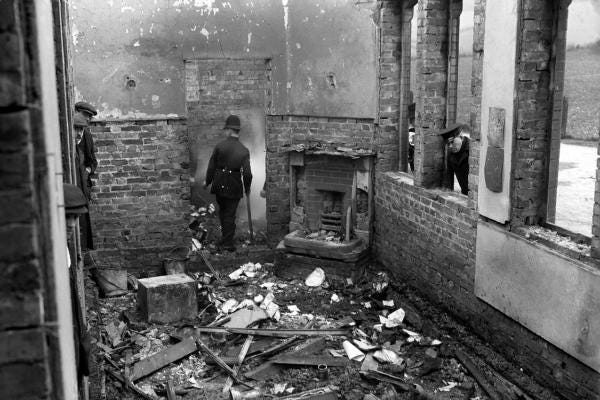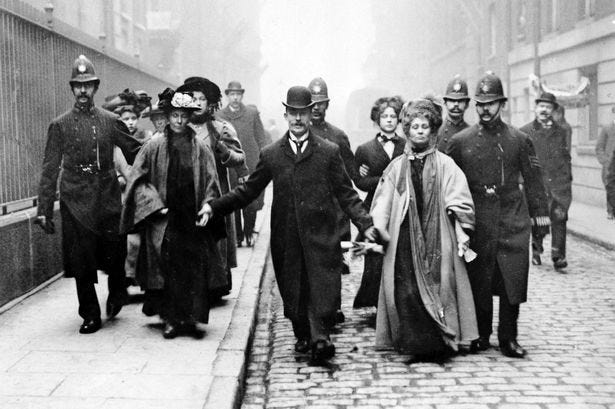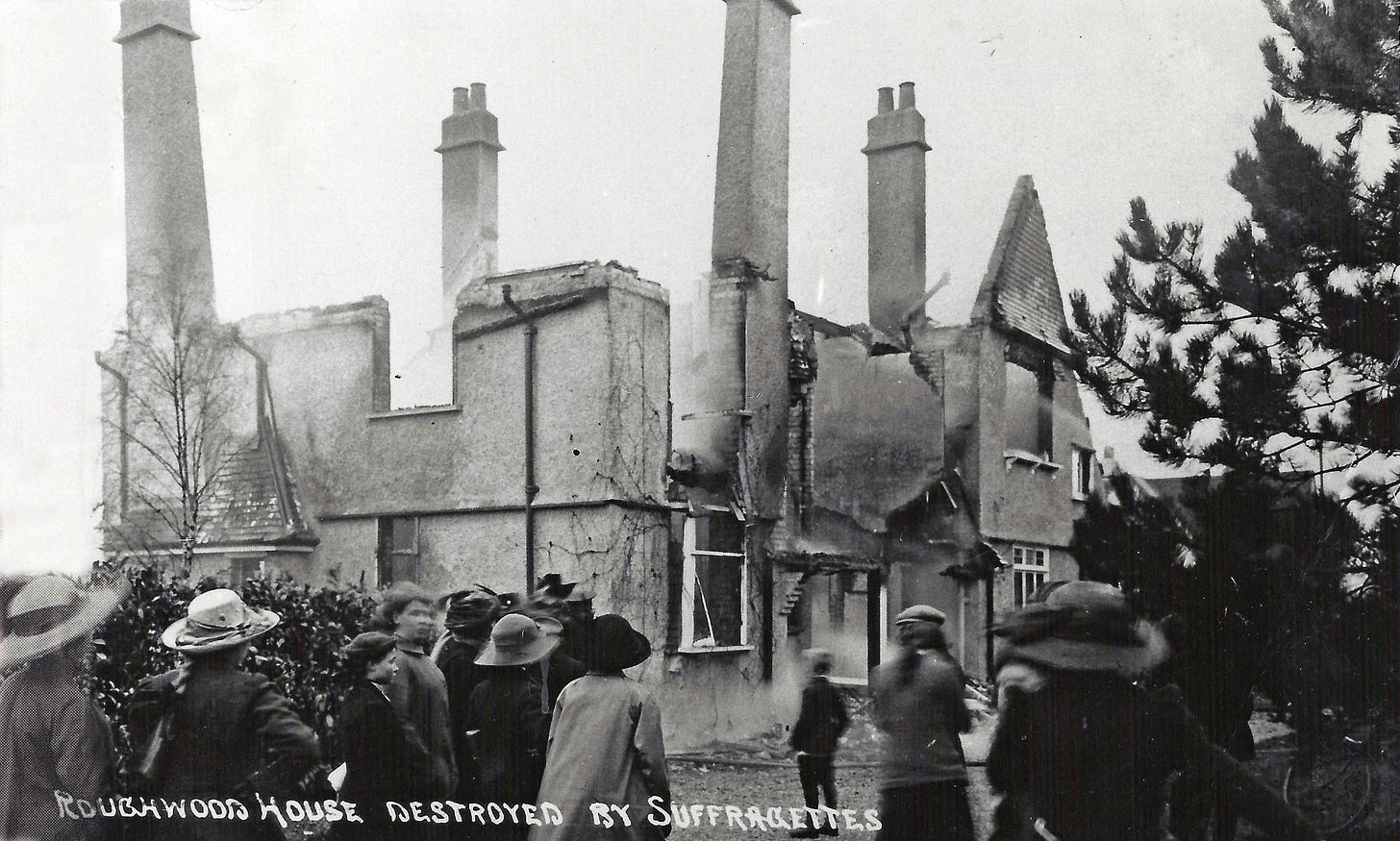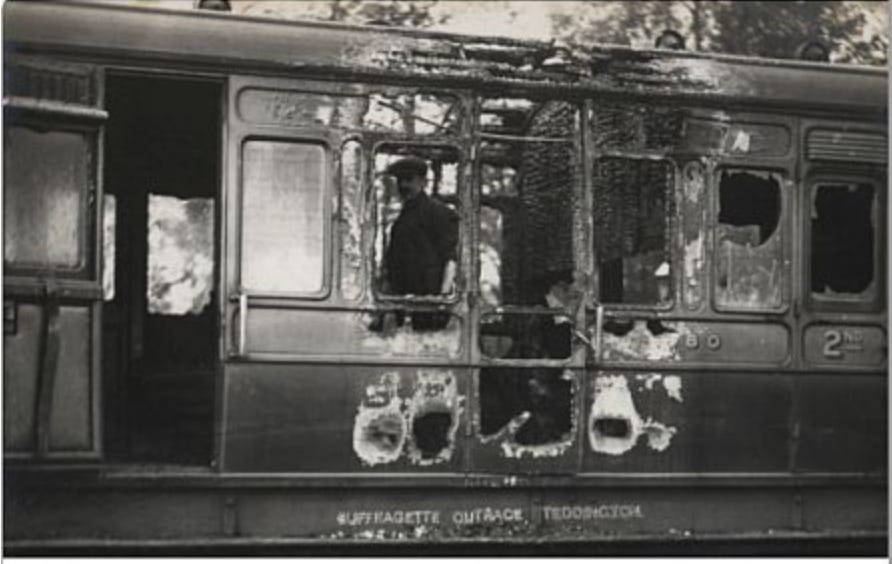Feminism’s Roots in Terrorism
Celebrated suffragette Emmeline Pankhurst defended terrorism by saying that at a time of injustice, it was inexcusable not to set off bombs
In my last Substack post, I traced the justification of “liberatory violence” to Frankfurt School icon Herbert Marcuse, who claimed that the violence of the oppressed, allegedly dedicated to ending intolerable injustice, was of a different order than state-authorized violence (that of government agencies, the police, the legal system, etc.) that maintained an unjust status quo. Radical feminism imbibed this convenient distinction from cultural Marxism, and trans radicalism took it from radical feminism.
But the glorification of destruction and violence was a part of radical feminism much earlier, as documented in Simon Webb’s must-read The Suffragette Bombers: Britain’s Forgotten Terrorists (2014, 2021). Members of the Women’s Social and Political Union (WSPU), formed in 1903 by orator and revolutionary Emmeline Pankhurst, terrorized the United Kingdom in the decade before the First World War with a campaign of bombings, arson, and physical violence (“Deeds, not words”) that brought enormous destruction and threat to life throughout England, Scotland, and Northern Ireland. At least five people died as a result of suffragette actions and dozens more were seriously injured. Yet today a statue honors the WSPU leader in Westminster’s Victoria Tower Gardens, and the suffragettes are seen largely as self-sacrificing heroines.
In addition to targeting centuries-old churches and many other priceless historical buildings, as well as countless small businesses and shops (threatening shop-owners that if they didn’t display suffragette literature, they would have their windows smashed), the WSPU even attempted to assassinate political leaders and magistrates, once in 1912 by throwing a hatchet at Prime Minister Herbert Asquith, which sliced through an Irish MP’s cheek and ear. They burned country homes to the ground and destroyed railway stations, canals, greenhouses, aqueducts, dockyards, military barracks, bridges, golf course pavilions, sports facilities, hotels, and many other such buildings.
The pointless cruelty of suffragettes’ years-long terror campaign, as well as statements by Pankhurst herself, strongly suggest that the right to vote was to some degree merely a pretext for suffragette actions. The actual aim was to foment a sex war, to express a deep hatred for the male sex, to attempt to provoke retaliatory violence from men (it is amazing it didn’t provoke more), and to create a lasting sex-divide of suspicion and hostility that would transform British society. In that last endeavor, they were partially successful.
Then as now, suffragettes profited from the (always denied) fact that violence by women was never taken as seriously as violence against women. Authorities were afraid of punishing convicted arsonists and assassins too harshly, and the suffragettes knew it. Leader Emmeline Pankhurst even boasted about the inability of officials to keep her in prison: “Four times they took me back again; four times I burst the prison door open” (“Why We Are Militant,” Suffrage and the Pankhursts, p. 162). During the time she was directing the WSPU’s criminal operations, she was able to travel across the Atlantic, giving speeches and collecting a massive war chest from adulatory supporters.
Pankhurst’s 1913 speech “Why We Are Militant” (in Suffrage and the Pankhursts) given in New York City at the peak of WSPU terrorism, showed Pankhurst boasting about the righteousness of her army’s actions, beginning with the claim that the militants had no choice but to set off the bombs, having already exhausted every peaceful political means.
“I want to say here and now that the only justification for violence, the only justification for damage to property, the only justification for risk to the comfort of other human beings,” she stated, “is the fact that you have tried all other available means and have failed to secure justice, and as a law-abiding person—and I am by nature a law-abiding person, as one hating violence, hating disorder—I want to say that from the moment we began our militant agitation to this day I have felt absolutely guiltless in this matter” (p. 156).
Typical in this statement was the downplaying of the reality of WSPU violence, a downplaying that a shocking number of historians and commentators, especially feminist ones, have largely continued (see, for example, the introduction by feminist professor Jane Marcus to Suffrage and the Pankhursts, which makes nary a mention of fire-bombing and physical attacks). The postal workers whose hands were permanently disfigured by suffragette letter bombs surely did not class the mixture of phosphorus and sulfuric acid poured into letter boxes a mere “risk to their comfort” or act of “disorder.” Neither, surely, did the hundreds of servants in country estates who awoke in the night to flee for their lives from fire; nor the shop-keepers who lost their businesses because they could not pay the significant cost of replacing broken windows, nor their employees who thus found themselves without work. All of these are quietly annihilated by Pankhurst’s self-excusing rhetoric.
It is also far from clear that the suffragettes had “tried all other available means.” Woman suffrage had been a live issue for a few decades at most during a tumultuous period in British history that saw the government struggling to contain working-class unrest, the possibility of civil war in Ireland, and colonial rebellion in India. The fact that a woman suffrage bill had not yet been passed by Parliament did not mean that it would not be. Moreover, Pankhurst’s obsession with female disempowerment obscured the reality that at least 40% of poor and propertyless men in Britain also lacked the right to vote, and were never mentioned in suffragette demands. The previous half century had seen millions of Britons receive the right to vote for the first time. Pankhurst’s emphasis on the unendurable injustice to women did not match the reality of Britain’s gradual democratic reform process, which would undoubtedly have spread to women without a single destroyed church or terrorized postal worker.
Pankhurst’s speech justified the violence of her organization with hyperbolic claims and the illogic typical of extremists. She began by alleging that “the time [was] long past when it became necessary for women to revolt in order to maintain their self-respect in Great Britain.” This was partly because, as Pankhurst alleged, they had come to realize that “to men, women are not human beings like themselves. Some men think we are superhuman; they put us on pedestals; … Other men think us sub-human.” Pankhurst failed to make clear how sending letter bombs to magistrates (as was done to Henry Curtis-Bennett in 1913) or blowing up the home of a Liberal cabinet minister (as was done to David Lloyd George in the same year) would convince anybody that women deserved an equal say in the democratic process.
Perhaps most interesting for our purposes was Pankhurst’s claim that it would be more wrong not to attempt to blow up the Bank of England (a suffragette bomb outside the bank was discovered and dismantled before it could go off in 1913) than it was to do so, despite the threat to innocent life and to political stability. Here the logic of the radical mindset is most succinctly captured: in an era of extreme (reputed) injustice, extremist action is less extreme than rational argument or peaceful protest.
Women’s grievances were “so pressing,” Pankhurst explained to her supporters, “that, so far from it being a duty to be patient and to wait for evolution, in thinking of those grievances, the idea of patience is intolerable. We feel that patience is something akin to crime when our patience involves continued suffering on the part of the oppressed.”
Here was the major philosophical plank of the radical arm of the feminist movement: that non-violence is a kind of culpability because it enables other violence to continue. Therefore, violence in protest is not only justifiable but necessary. Herbert Marcuse would have been proud.
In order for Pankhurst to defend WSPU violence, she needed to claim that the evils women were suffering were not only profound but were preventable through woman suffrage and only through woman suffrage. Pankhurst could not admit that many of the reforms that women had lobbied for in the nineteenth century (reforms to protect women’s property rights in marriage, for example) had been passed by an all-male parliament sympathetic to women’s demands (see Brian Harrison, Separate Spheres: The Opposition to Women’s Suffrage in Britain, p. 73).
In declaring the necessity of suffragette violence, Pankhurst mentioned prostitution as a source of women’s suffering, and framed that suffering as a morally unambiguous atrocity on a level with slavery, or even worse: “When I was a very tiny child,” she began, “the great American people were divided into hostile sections on the question of whether it was right that one set of human beings of one colour should buy and sell human beings of another color, and you had a bloody war to settle that question. I tell you that throughout the civilized world to-day there is a slavery more awful than negro slavery in its worst form ever was. It is called prostitution, but in that awful slavery there are slaves of every shade and colour, and they are all of one sex.”
Pankhurst never considered that prostitution was not the same as slavery in that women were not literally owned but were instead paid for services they offered and, unlike slaves, kept the wages they earned. Neither did she acknowledge the brutal conditions of many male workers, even male prostitutes. She would not admit that some women chose prostitution, and that providing means of economic self-sufficiency other than prostitution was a far more useful remedy than the ballot. The symbolism of voting—or perhaps merely the exhilaration of direct action—had become so essential to Pankhurst that she clearly preferred melodramatic metaphor and hyperbolic accusation to genuine solutions to women’s problems. Her rhetoric was damning, overblown, false, but nonetheless authoritative and attractive to many.
Suffragettes believed they could largely get away with their violence and in a sense, they did get away with it in that they are today widely regarded as victim-heroines. Like many zealots, the suffragettes believed that violence and destruction were justified when undertaken for an allegedly unimpeachable cause, and the fruits of such self-delusion are still evident amongst radical ideologues today.







hating violence, hating disorder—I want to say that from the moment we began our militant agitation to this day I have felt absolutely guiltless in this matter” (p. 156).
Nice of her to admit that she was a psychopath.
Pankhurst also did a deal with Lord Balfour that if they supported WW1 recruitment middle class women would get the vote post war. Hence the white feather campaign in the UK and here in Australia. Rich entitled women shaming men to go to the western front.
These women had no shame my grandfather a doctor on the western front (think the film 1917 with my grandad's batman shooting the hopelessly wounded with granddad' revolver and with no morphia Then whilst on leave in London grandad was having a meal with a friend who was in civilian clothing when a bumptious suffragette stormed up handed his friend 'the feather' and called him a coward. My grandfather's friend then called the waiter to bring his crutches for you see he had lost a leg at the battle of Loos!
Some women had the vote in some cases where other women and men did not. There were property or educational franchises in most state upper houses in Australia until the 1950's and with local councils until the 1980's. Hence my grandmother could vote for the the Victorian legislative council and the local council when many men could not. I was pilloried for raising this (as a teacher) of a compulsory year 11 subject called Australian studies.